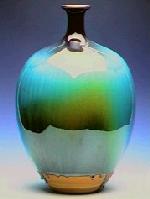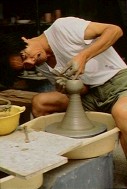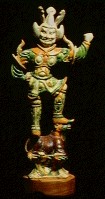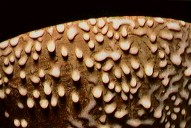 |
Chinese
Pottery and Porcelain |
The origins of
Chinese pottery and porcelain go back to distant antiquity. And from the
masterful excellence of Chinese ceramics, we can deduce the painstaking labor
that went into making them. In the National Palace Museum in Taipei, you will
find many outstanding examples of nearly translucent eggshell china. Painted on
the surfaces of these Ming (1368-1644 A.D.) and Ch'ing (1644-1911 A.D.) period
pieces are delicate flowers, grasses, birds, and beasts that make one sigh and
wonder how such fine work was ever produced.
Four objective factors influenced the
beginnings and development of Chinese pottery and porcelain: clay, fuel, river
systems, and markets. Heavy clay and large quantities of fuel are required for
pottery and porcelain making. Prohibitively high shipping costs made pottery
production economically impractical in areas without these basic prerequisites.
So a locale with plentiful supplies of both clay and lumber as fuel had the best
potential for setting up a ceramics kiln.
 Once a large kiln has been set up,
it often continues to produce for hundreds of years. The arts of preparing clay,
glazing, and firing are often passed down from generation to generation; so each
area will tend to develop its own individual glazes, clays, and decorating
techniques, resulting in unique styles and designs. These special
characteristics provide much of the basis of modern appraisal of ancient pottery
and porcelain pieces: from the particular features of a piece, one can usually
pinpoint definitively when and where it was made. Beginning with the Han Dynasty
(206 B.C.-220 A.D.), and into the T'ang (618-907 A.D.), Sung (960-1279 A.D.),
Yuan (1279-1368 A.D.), and Ming (1368-1644 A.D.) dynasties, large quantities of
pottery and porcelain were exported from China to Korea, Japan, the Ryukyu
Islands, the Southeast Asian peninsula, the Philippines, Indonesia, India, the
Middle East, the eastern coast of Africa, continental Europe, Great Britain, and
the United States. Pottery and porcelain pieces exported during these periods
are an excellent source of research materials on the history of China's
communications, trade, and economic relations with other countries. Once a large kiln has been set up,
it often continues to produce for hundreds of years. The arts of preparing clay,
glazing, and firing are often passed down from generation to generation; so each
area will tend to develop its own individual glazes, clays, and decorating
techniques, resulting in unique styles and designs. These special
characteristics provide much of the basis of modern appraisal of ancient pottery
and porcelain pieces: from the particular features of a piece, one can usually
pinpoint definitively when and where it was made. Beginning with the Han Dynasty
(206 B.C.-220 A.D.), and into the T'ang (618-907 A.D.), Sung (960-1279 A.D.),
Yuan (1279-1368 A.D.), and Ming (1368-1644 A.D.) dynasties, large quantities of
pottery and porcelain were exported from China to Korea, Japan, the Ryukyu
Islands, the Southeast Asian peninsula, the Philippines, Indonesia, India, the
Middle East, the eastern coast of Africa, continental Europe, Great Britain, and
the United States. Pottery and porcelain pieces exported during these periods
are an excellent source of research materials on the history of China's
communications, trade, and economic relations with other countries.
 Clay suitable for pottery and
porcelain making is produced in the Peitou and Nanshihchiao areas of Taipei.
Beginning in the late 19th and early 20th centuries, pottery and porcelain kilns
gradually became concentrated in the Yingke Chen area of Taipei County. Today,
Yingke Chen is the main ceramic-producing area of northern Taiwan. Due to the
accumulation of ceramic-making experience over the years, and the ceramic
masters residing in Yingke Chen who have received their craft from previous
generations, modern kiln facilities continue to come to Yingke Chen to set up
shop. The pottery and porcelain producing centers of central Taiwan are in
Miaoli and Nantou counties. Thanks mainly to the plentiful supplies of stoneware
clay and rich forest resources of the Shihtoushan area, kilns have sprung up all
over these two counties. Some of the kilns in the Miaoli area have begun using
natural gas as a fuel for firing pottery. They also import high-quality
porcelain clay, and have brought in modern facilities and technologies to
further improve the quality of their products. Clay suitable for pottery and
porcelain making is produced in the Peitou and Nanshihchiao areas of Taipei.
Beginning in the late 19th and early 20th centuries, pottery and porcelain kilns
gradually became concentrated in the Yingke Chen area of Taipei County. Today,
Yingke Chen is the main ceramic-producing area of northern Taiwan. Due to the
accumulation of ceramic-making experience over the years, and the ceramic
masters residing in Yingke Chen who have received their craft from previous
generations, modern kiln facilities continue to come to Yingke Chen to set up
shop. The pottery and porcelain producing centers of central Taiwan are in
Miaoli and Nantou counties. Thanks mainly to the plentiful supplies of stoneware
clay and rich forest resources of the Shihtoushan area, kilns have sprung up all
over these two counties. Some of the kilns in the Miaoli area have begun using
natural gas as a fuel for firing pottery. They also import high-quality
porcelain clay, and have brought in modern facilities and technologies to
further improve the quality of their products.
 The key to why ceramic art has been
able to develop to such a high level in China lies in the spirit of Chinese
craftsmen to strive for excellence. Ceramic and porcelain pieces dating back to
various historical periods have demonstrated again and again how Chinese
artisans overcame the shortcomings of the materials they used, and how
craftsmanship can conquer the difficulties encountered in working with clay. For
example, in the late Yuan (1279-1368 A.D.) and early Ming (1368-1644 A.D.)
dynasties, the material used to produce porcelain in world-famous Chingte Chen,
Kiangsi Province, was porcelain stone mixed with kaolin, a material with
relatively poor plasticity. Faced with this difficulty, the porcelain makers of
the time came up with the idea of grinding the raw material to an extremely fine
consistency, then soaking it in water for several years. This process of
hydrolysis increased its stickiness and plasticity. In this way the clay could
be stretched and formed on a potter's wheel into beautiful porcelain articles.
When half-dry, a special knife was used to shave it until extremely thin; this
is how the famous Chinese "Eggshell" porcelain-a product of the official kin of
the Ming and Ch'ing dynasties-was made. Modern porcelain makers would today be
hard put to reproduce this unique process for treating porcelain clay, and the
highly developed craftsmanship that accompanied it-even with their
state-of-the-art equipment and technologies. The key to why ceramic art has been
able to develop to such a high level in China lies in the spirit of Chinese
craftsmen to strive for excellence. Ceramic and porcelain pieces dating back to
various historical periods have demonstrated again and again how Chinese
artisans overcame the shortcomings of the materials they used, and how
craftsmanship can conquer the difficulties encountered in working with clay. For
example, in the late Yuan (1279-1368 A.D.) and early Ming (1368-1644 A.D.)
dynasties, the material used to produce porcelain in world-famous Chingte Chen,
Kiangsi Province, was porcelain stone mixed with kaolin, a material with
relatively poor plasticity. Faced with this difficulty, the porcelain makers of
the time came up with the idea of grinding the raw material to an extremely fine
consistency, then soaking it in water for several years. This process of
hydrolysis increased its stickiness and plasticity. In this way the clay could
be stretched and formed on a potter's wheel into beautiful porcelain articles.
When half-dry, a special knife was used to shave it until extremely thin; this
is how the famous Chinese "Eggshell" porcelain-a product of the official kin of
the Ming and Ch'ing dynasties-was made. Modern porcelain makers would today be
hard put to reproduce this unique process for treating porcelain clay, and the
highly developed craftsmanship that accompanied it-even with their
state-of-the-art equipment and technologies.

 Pottery and porcelain artisans of
today have full access to modern technological knowledge, and can freely choose
their equipment. But they all still carry on in the traditional belief that man
can indeed conquer nature. Some imitate ancient designs, others produce
avant-garde pieces. With their minds, their hands, and clay and fire, these
potters express the artist's perception of beauty, his professional experience,
his sensitivity, and his level of artistic cultivation. A senior potter of
Taiwan, Lin Pap-chia , has over the past 40 years come to be known as the
"doctor" of the Yingke Chen ceramics industry. He can usually come up with an
answer to virtually any question or problem regarding ceramics that is brought
to him, and he has also helped to cultivate uncounted creative talent in the
area of ceramic making. Chiu Huan-tang and Shin Nai-yueh made their
contributions by bringing in new ceramic making concepts from the United States,
and by creating modern works of ceramic art. These masters have also helped
train a new generation of ceramists in their art. Young artists who have
distinguished themselves in their field include Lien Pao-chai, Chen Chiu-chi,
Yang Wen-ni, Sun Chao, and Feng Sheng-kuang. All have their own richly
expressive and creative styles. Pottery and porcelain artisans of
today have full access to modern technological knowledge, and can freely choose
their equipment. But they all still carry on in the traditional belief that man
can indeed conquer nature. Some imitate ancient designs, others produce
avant-garde pieces. With their minds, their hands, and clay and fire, these
potters express the artist's perception of beauty, his professional experience,
his sensitivity, and his level of artistic cultivation. A senior potter of
Taiwan, Lin Pap-chia , has over the past 40 years come to be known as the
"doctor" of the Yingke Chen ceramics industry. He can usually come up with an
answer to virtually any question or problem regarding ceramics that is brought
to him, and he has also helped to cultivate uncounted creative talent in the
area of ceramic making. Chiu Huan-tang and Shin Nai-yueh made their
contributions by bringing in new ceramic making concepts from the United States,
and by creating modern works of ceramic art. These masters have also helped
train a new generation of ceramists in their art. Young artists who have
distinguished themselves in their field include Lien Pao-chai, Chen Chiu-chi,
Yang Wen-ni, Sun Chao, and Feng Sheng-kuang. All have their own richly
expressive and creative styles.
 In the Taiwan, some ceramists have
learned their craft on their own, others through study abroad; but most received
their training from the National Taiwan Academy of Arts, the industrial arts
department of National Taiwan Normal University, and the ceramics section of the
Chemical Engineering Department of the Chinese Culture University. Accompanying
the rise in the standard of living in Taiwan, the number of people who enjoy
ceramics and themselves like to throw pots is increasing every year. Those who
have actually dug into clay with their own hands have the highest appreciation
of the masterful creations of the ancient makers of pottery and porcelain. In
meeting the challenge of modern art by merging it with traditional culture,
Chinese ceramic art looks toward wholly new creative and innovative horizons. In the Taiwan, some ceramists have
learned their craft on their own, others through study abroad; but most received
their training from the National Taiwan Academy of Arts, the industrial arts
department of National Taiwan Normal University, and the ceramics section of the
Chemical Engineering Department of the Chinese Culture University. Accompanying
the rise in the standard of living in Taiwan, the number of people who enjoy
ceramics and themselves like to throw pots is increasing every year. Those who
have actually dug into clay with their own hands have the highest appreciation
of the masterful creations of the ancient makers of pottery and porcelain. In
meeting the challenge of modern art by merging it with traditional culture,
Chinese ceramic art looks toward wholly new creative and innovative horizons.
|
 |

 Once a large kiln has been set up,
it often continues to produce for hundreds of years. The arts of preparing clay,
glazing, and firing are often passed down from generation to generation; so each
area will tend to develop its own individual glazes, clays, and decorating
techniques, resulting in unique styles and designs. These special
characteristics provide much of the basis of modern appraisal of ancient pottery
and porcelain pieces: from the particular features of a piece, one can usually
pinpoint definitively when and where it was made. Beginning with the Han Dynasty
(206 B.C.-220 A.D.), and into the T'ang (618-907 A.D.), Sung (960-1279 A.D.),
Yuan (1279-1368 A.D.), and Ming (1368-1644 A.D.) dynasties, large quantities of
pottery and porcelain were exported from China to Korea, Japan, the Ryukyu
Islands, the Southeast Asian peninsula, the Philippines, Indonesia, India, the
Middle East, the eastern coast of Africa, continental Europe, Great Britain, and
the United States. Pottery and porcelain pieces exported during these periods
are an excellent source of research materials on the history of China's
communications, trade, and economic relations with other countries.
Once a large kiln has been set up,
it often continues to produce for hundreds of years. The arts of preparing clay,
glazing, and firing are often passed down from generation to generation; so each
area will tend to develop its own individual glazes, clays, and decorating
techniques, resulting in unique styles and designs. These special
characteristics provide much of the basis of modern appraisal of ancient pottery
and porcelain pieces: from the particular features of a piece, one can usually
pinpoint definitively when and where it was made. Beginning with the Han Dynasty
(206 B.C.-220 A.D.), and into the T'ang (618-907 A.D.), Sung (960-1279 A.D.),
Yuan (1279-1368 A.D.), and Ming (1368-1644 A.D.) dynasties, large quantities of
pottery and porcelain were exported from China to Korea, Japan, the Ryukyu
Islands, the Southeast Asian peninsula, the Philippines, Indonesia, India, the
Middle East, the eastern coast of Africa, continental Europe, Great Britain, and
the United States. Pottery and porcelain pieces exported during these periods
are an excellent source of research materials on the history of China's
communications, trade, and economic relations with other countries.  Clay suitable for pottery and
porcelain making is produced in the Peitou and Nanshihchiao areas of Taipei.
Beginning in the late 19th and early 20th centuries, pottery and porcelain kilns
gradually became concentrated in the Yingke Chen area of Taipei County. Today,
Yingke Chen is the main ceramic-producing area of northern Taiwan. Due to the
accumulation of ceramic-making experience over the years, and the ceramic
masters residing in Yingke Chen who have received their craft from previous
generations, modern kiln facilities continue to come to Yingke Chen to set up
shop. The pottery and porcelain producing centers of central Taiwan are in
Miaoli and Nantou counties. Thanks mainly to the plentiful supplies of stoneware
clay and rich forest resources of the Shihtoushan area, kilns have sprung up all
over these two counties. Some of the kilns in the Miaoli area have begun using
natural gas as a fuel for firing pottery. They also import high-quality
porcelain clay, and have brought in modern facilities and technologies to
further improve the quality of their products.
Clay suitable for pottery and
porcelain making is produced in the Peitou and Nanshihchiao areas of Taipei.
Beginning in the late 19th and early 20th centuries, pottery and porcelain kilns
gradually became concentrated in the Yingke Chen area of Taipei County. Today,
Yingke Chen is the main ceramic-producing area of northern Taiwan. Due to the
accumulation of ceramic-making experience over the years, and the ceramic
masters residing in Yingke Chen who have received their craft from previous
generations, modern kiln facilities continue to come to Yingke Chen to set up
shop. The pottery and porcelain producing centers of central Taiwan are in
Miaoli and Nantou counties. Thanks mainly to the plentiful supplies of stoneware
clay and rich forest resources of the Shihtoushan area, kilns have sprung up all
over these two counties. Some of the kilns in the Miaoli area have begun using
natural gas as a fuel for firing pottery. They also import high-quality
porcelain clay, and have brought in modern facilities and technologies to
further improve the quality of their products.  The key to why ceramic art has been
able to develop to such a high level in China lies in the spirit of Chinese
craftsmen to strive for excellence. Ceramic and porcelain pieces dating back to
various historical periods have demonstrated again and again how Chinese
artisans overcame the shortcomings of the materials they used, and how
craftsmanship can conquer the difficulties encountered in working with clay. For
example, in the late Yuan (1279-1368 A.D.) and early Ming (1368-1644 A.D.)
dynasties, the material used to produce porcelain in world-famous Chingte Chen,
Kiangsi Province, was porcelain stone mixed with kaolin, a material with
relatively poor plasticity. Faced with this difficulty, the porcelain makers of
the time came up with the idea of grinding the raw material to an extremely fine
consistency, then soaking it in water for several years. This process of
hydrolysis increased its stickiness and plasticity. In this way the clay could
be stretched and formed on a potter's wheel into beautiful porcelain articles.
When half-dry, a special knife was used to shave it until extremely thin; this
is how the famous Chinese "Eggshell" porcelain-a product of the official kin of
the Ming and Ch'ing dynasties-was made. Modern porcelain makers would today be
hard put to reproduce this unique process for treating porcelain clay, and the
highly developed craftsmanship that accompanied it-even with their
state-of-the-art equipment and technologies.
The key to why ceramic art has been
able to develop to such a high level in China lies in the spirit of Chinese
craftsmen to strive for excellence. Ceramic and porcelain pieces dating back to
various historical periods have demonstrated again and again how Chinese
artisans overcame the shortcomings of the materials they used, and how
craftsmanship can conquer the difficulties encountered in working with clay. For
example, in the late Yuan (1279-1368 A.D.) and early Ming (1368-1644 A.D.)
dynasties, the material used to produce porcelain in world-famous Chingte Chen,
Kiangsi Province, was porcelain stone mixed with kaolin, a material with
relatively poor plasticity. Faced with this difficulty, the porcelain makers of
the time came up with the idea of grinding the raw material to an extremely fine
consistency, then soaking it in water for several years. This process of
hydrolysis increased its stickiness and plasticity. In this way the clay could
be stretched and formed on a potter's wheel into beautiful porcelain articles.
When half-dry, a special knife was used to shave it until extremely thin; this
is how the famous Chinese "Eggshell" porcelain-a product of the official kin of
the Ming and Ch'ing dynasties-was made. Modern porcelain makers would today be
hard put to reproduce this unique process for treating porcelain clay, and the
highly developed craftsmanship that accompanied it-even with their
state-of-the-art equipment and technologies. 
 Pottery and porcelain artisans of
today have full access to modern technological knowledge, and can freely choose
their equipment. But they all still carry on in the traditional belief that man
can indeed conquer nature. Some imitate ancient designs, others produce
avant-garde pieces. With their minds, their hands, and clay and fire, these
potters express the artist's perception of beauty, his professional experience,
his sensitivity, and his level of artistic cultivation. A senior potter of
Taiwan, Lin Pap-chia , has over the past 40 years come to be known as the
"doctor" of the Yingke Chen ceramics industry. He can usually come up with an
answer to virtually any question or problem regarding ceramics that is brought
to him, and he has also helped to cultivate uncounted creative talent in the
area of ceramic making. Chiu Huan-tang and Shin Nai-yueh made their
contributions by bringing in new ceramic making concepts from the United States,
and by creating modern works of ceramic art. These masters have also helped
train a new generation of ceramists in their art. Young artists who have
distinguished themselves in their field include Lien Pao-chai, Chen Chiu-chi,
Yang Wen-ni, Sun Chao, and Feng Sheng-kuang. All have their own richly
expressive and creative styles.
Pottery and porcelain artisans of
today have full access to modern technological knowledge, and can freely choose
their equipment. But they all still carry on in the traditional belief that man
can indeed conquer nature. Some imitate ancient designs, others produce
avant-garde pieces. With their minds, their hands, and clay and fire, these
potters express the artist's perception of beauty, his professional experience,
his sensitivity, and his level of artistic cultivation. A senior potter of
Taiwan, Lin Pap-chia , has over the past 40 years come to be known as the
"doctor" of the Yingke Chen ceramics industry. He can usually come up with an
answer to virtually any question or problem regarding ceramics that is brought
to him, and he has also helped to cultivate uncounted creative talent in the
area of ceramic making. Chiu Huan-tang and Shin Nai-yueh made their
contributions by bringing in new ceramic making concepts from the United States,
and by creating modern works of ceramic art. These masters have also helped
train a new generation of ceramists in their art. Young artists who have
distinguished themselves in their field include Lien Pao-chai, Chen Chiu-chi,
Yang Wen-ni, Sun Chao, and Feng Sheng-kuang. All have their own richly
expressive and creative styles.  In the Taiwan, some ceramists have
learned their craft on their own, others through study abroad; but most received
their training from the National Taiwan Academy of Arts, the industrial arts
department of National Taiwan Normal University, and the ceramics section of the
Chemical Engineering Department of the Chinese Culture University. Accompanying
the rise in the standard of living in Taiwan, the number of people who enjoy
ceramics and themselves like to throw pots is increasing every year. Those who
have actually dug into clay with their own hands have the highest appreciation
of the masterful creations of the ancient makers of pottery and porcelain. In
meeting the challenge of modern art by merging it with traditional culture,
Chinese ceramic art looks toward wholly new creative and innovative horizons.
In the Taiwan, some ceramists have
learned their craft on their own, others through study abroad; but most received
their training from the National Taiwan Academy of Arts, the industrial arts
department of National Taiwan Normal University, and the ceramics section of the
Chemical Engineering Department of the Chinese Culture University. Accompanying
the rise in the standard of living in Taiwan, the number of people who enjoy
ceramics and themselves like to throw pots is increasing every year. Those who
have actually dug into clay with their own hands have the highest appreciation
of the masterful creations of the ancient makers of pottery and porcelain. In
meeting the challenge of modern art by merging it with traditional culture,
Chinese ceramic art looks toward wholly new creative and innovative horizons.